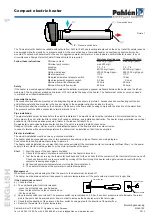
1.
Constant supervision of the torch is required when
the torch is in use.
2.
Do not attempt to install, repair, or service this torch
or the gas supply line unless you have continuing
expert training and knowledge of gas heaters.
Qualifications for service and installation of this
equipment are as follows:
a. To be a qualified gas heater service person, you
must have sufficient training and experience to
handle all aspects of gas-fired heater installation,
service and repair. This includes the task of
installation, troubleshooting, replacement of
defective parts and testing of the heater. You
must be able to place the heater into a continuing
safe and normal operating condition. You must
completely familiarize yourself with each model
heater by reading and complying with the safety
instructions, labels, Owner’s Manual, etc., that is
provided with each heater.
b. To be a qualified gas installation person, you must
have sufficient training and experience to handle
all aspects of installing, repairing and altering gas
lines, including selecting and installing the proper
equipment, and selecting proper pipe and tank
size to be used. This must be done in accordance
with all local, state and national codes as well as
the manufacturer’s requirements.
3.
All installations and applications of PSI torches must
meet all relevant local, state and national codes.
Included are L.P. gas, natural gas, electrical, and
safety codes. Your local fuel gas supplier, the local
fire department or similar government agencies, or
your insurance agent can help you determine code
requirements.
-- ANSI/NFPA 58, latest edition, Standard for
Storage and Handling of Liquefied Petroleum
Gas and/or
-- ANSI Z223.1/NFPA 54, National Fuel Gas
Code
4.
We cannot anticipate every use which may be made
of our torches. Check with the local fire safety
authority if you have questions about applications.
5.
Do not locate fuel gas containers or fuel supply hoses
within 20 ft. of the discharge of the torch.
6.
Do not block air intakes or discharge outlets of the
torch. Doing so may cause improper combustion or
damage to torch components leading to property
damage.
7.
The hose assembly shall be visually inspected on a
daily basis after torch relocation and when the torch
is in use. If it is evident there is excessive abrasion or
wear, or if the hose is cut, it must be replaced prior to
the torch being put into operation. The hose
assembly shall be protected from building materials,
and contact with hot surfaces during use. The hose
assembly shall be that specified by the manufacturer.
See parts list.
8.
Check for gas leaks and proper function upon initial
use, when relocating, and after servicing. Refer to
leak check instructions within installation section of
this manual.
9.
This torch should be inspected for proper operation by
a qualified service person before each use and at
least annually.
10.
Always turn off the gas supply to the torch if the torch
is not in use.
11.
If gas flow is interrupted and flame goes out, do not
relight the torch until you are sure that all gas that
may have accummulated has cleared away. In any
event, do not relight the torch for at least 5 minutes.
12.
This torch may be used with a minimum size 20 lb.
capacity propane container when por tability is
desired. However, this size will not provide sufficient
vaporization and pressure for extended torch
operation. Ensure that additional 20lb. containers are
available, or use a larger gas container (50 or 100
lb.).
13.
W h e n t h e to rc h i s to b e s to r e d i n d o o r s , t h e
c o n n e c t i o n b e t we e n t h e p ro p a n e g a s s u p p l y
cylinder(s) and the torch must be disconnected and
the cylinder(s) removed from the torch and stored in
accordance with Chapter 5 if the Standard for the
Storage and Handling of Liquified Petroleum Gases,
ANSI/NFPA 58.
6
WARNING
Fire and Burn Hazard.
Can Cause Property Damage, Severe Injury or Death.
■
Torches produce an intense and extremely hot open
flame.
■
Always be aware of the direction of the torch’s burner
head relative to any combustible materials when
torch is lit.
WARNING
Explosion and Fire Hazard.
■
Do not use this torch in an enclosure, such as a kiln.
■
This torch does not have a safety shut off control or
thermocouple.
■
Gas will continue to flow and accumulate if burner
flame is extinguished.
■
If ignited, accumulated gas will cause explosions or
fires leading to property damage, injury, or death.






























